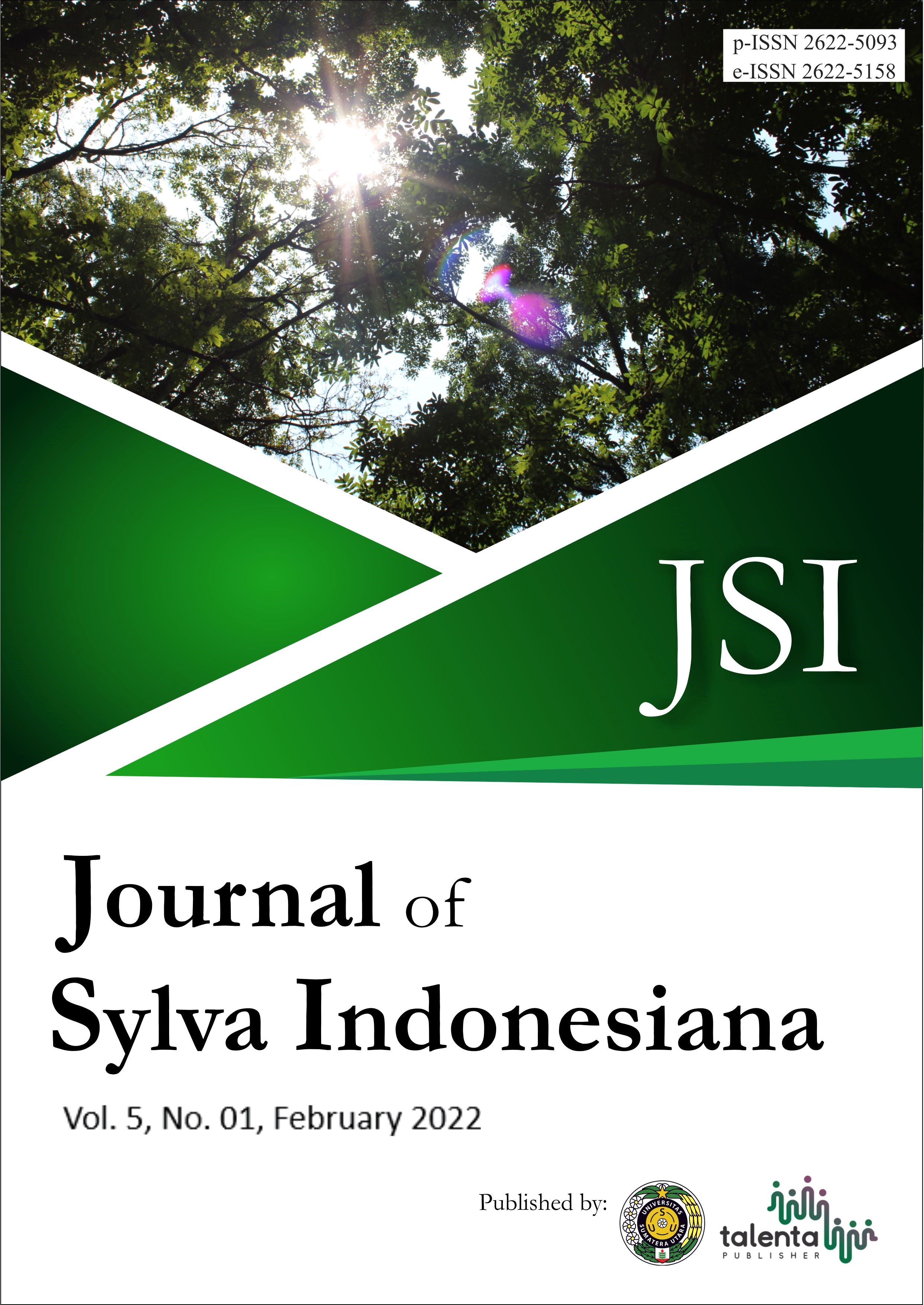Multi-temporal Satellite Images Analysis for Assessing and Mapping Deforestation in Um Hataba Forest, South Kordofan, Sudan
DOI:
https://doi.org/10.32734/jsi.v5i01.7504Keywords:
Landsat Images, Deforestation, Um Hataba Forest, Antrhopogenic factors, LULCAbstract
. Sudan is a hot spot for deforestation, despite the increasing awareness of deforestation and its consequences. Consequences are related to increased emissions of greenhouse gases, water pollution, and loss of biodiversity. However, precise information on its forests' current state is very limited. Therefore, to intervene support of existing resources effectively, it is important to have a better understanding of the process to take place in the country and impact those resources. The objective of this study is assess and map Land use Land cover (LULC) change and analyze the anthropogenic factors causing it in Um Hataba forest, South Kordofan State. The study utilized two-free cloud images (TM 2000 and Sentinel-2 in 2018), field surveys, and questionnaires to analyze the decrease in forest cover. The results indicated there were a decrease in vegetation cover on wadis (clay soil) from 20.98% in 2000 to 15.85% in 2018 and vegetation on sandy soil decreased from 30.29% in 2000 to 30.13% in 2018. While mixed shrubs and grassland increased from 28.60% in 2000 to 33.20% in 2018 of the total area under study and the rainfed agricultural area increased from 20.13% in 2000 to 20.82% in 2018. The main factors of degradation and fragmentation as the expansion of mechanized are rain-fed agriculture, felling of trees and woodcutting, worse grazing activities, and construction of infrastructure. Information garnered from this study can provide a good basis for forest rehabilitation programs and can also be used for developing proper management plans that consider the needs of the communities utilizing the forest.
Downloads
References
FAO (Food and Agriculture Organization of the United Nations), Trees, forests and land use in drylands: The first global assessment. FAO. Rome, Italy, 2016.
Abdel Nour H O., The status of Sudan forests and the changes that have occurred during the period 2000–2011. Nineteenth Annual Forestry Conference “Under the Slogan "Towards a Comprehensive Package for the Protection and Reconstruction of Forests". 24–27 April 2013. Khartoum: FNC (Forests National Corporation), 2013.
Siddig A A H, Abdel M T D, El-Nasry H M, Biodiversity of Sudan. In: Pullaiah T. Global Biodiversity (Vol. 3). Selected Countries in Africa. Waretown: Apple Academic Press, 275–294, 2019.
Bakr A, Siddig E, Eltohami A, “Threats to green gum arabic production in Sudanâ€, Biomedical Journal of Scientific and Technical Research, vol. 3, no. 5, pp.. 2018.
Niles JO, Brown S, Pretty J, Ball AS, Fay J, “Potential carbon mitigation and income in developing countries from changes in use and management of agricultural and forest landsâ€, Philos Trans A Math Phys Eng Sci vol. 360, no. 1797, pp. 1621-1639. 2002.
KKC R, Mahato DB, Yadav NK, Poudel P, “Mapping Deforestation and Forest Degradation Using CLASlite Approach (A Case Study from Maya Devi Collaborative Forest of Kapilvastu District, Nepal)â€, Int J Environ Sci Nat Res. Vol. 23, no. 5, pp. 556122. 2020
Birch JC, Thapa I, Balmford A, Bradbury RB, Brown C, “What benefits do community forests provide, and to whom? A rapid assessment of ecosystem services from a Himalayan forestâ€, Nepal. Ecosystem Services vol. 8, pp. 118-127. 2014.
FAO, Global Forest Resources Assessment 2015. FAO Forestry Paper No. 1 UN Food and Agricultural Organization, Rome, 2015.
Gadallah N A H., “Assessment of conservative and protective needs for natural forests in drylands: Case of Wad Al-Bashir Forest, Gedaref State, Sudanâ€, MSc Thesis, University of Khartoum, Khartoum, Sudan, 2019.
Lillesand TK., Remote Sensing and Image Interpretation. (7th edition), John Wiley, Chichester, 2004.
Lu DM, Mausel P, Brondizio E, Moran E, “Change detection techniquesâ€, International journal of remote sensing vol. 25, no. 12, pp. 2365-2401. 2004.
Hesbon OCHEGO., Application of Remote Sensing in Deforestation Monitoring: A Case Study of the Aberdares, Kenya, 2003.
Daldoum, D. M. A., & Massaud, M. M, “Regeneration and Establishment of Sclerocarya birrea (A. Rich.) Hochst. Subsp. birrea by Different Land Preparation Methods in the Dry Lands, Nuba Mountains (Rashad District)â€, Sudan Journal of Desertification Research vol. 4, pp. 122-180. 2018.
El Ghazali, G. E. B, “A Study on the Pollen Flora of Sudanâ€, Review of Palaeobotany and Palynology, vol. 76, pp. 99-345. 1993.
Eisawi, K. A. E., He, H., Shaheen, T., & Yasin, E. H. E, “Assessment of Tree Diversity and Abundance in Rashad Natural Reserved Forest, South Kordofan, Sudanâ€, Open Journal of Forestry, vol. 11, pp. 37-46. 2021.
Pantuliano, S., Changes and Potential Resilience of Food Systems in the Nuba Mountains Conflict (No. 05-07), 2005.
Downloads
Published
How to Cite
Issue
Section
License

This work is licensed under a Creative Commons Attribution-NonCommercial 4.0 International License.



















